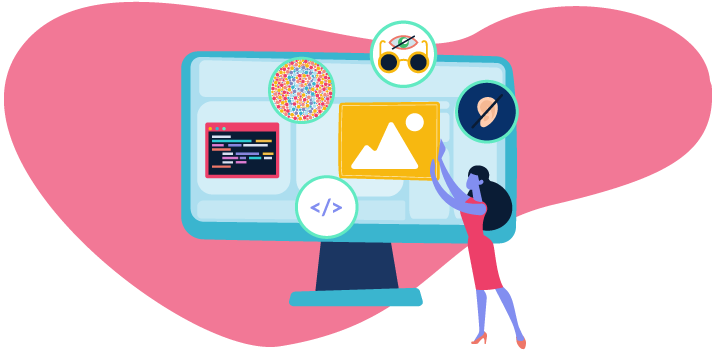Did you know that 15 to 20 percent of the population are affected by a disability of some kind, be it visual, movement related or auditory? In a connected, online society such as ours, it’s absolutely essential to optimise your site’s accessibility.
Web accessibility can be defined in terms of the range of techniques and practices used to make your e-commerce website accessible to as many people as possible (including people affected by a disability) and thus reach a much wider audience. This will then enable you to increase traffic and conversions across the various different pages that make up your site.
A well-prepared site will prevent you missing out on millions of potential visitors. Additionally, having a digitally accessible website will improve your SEO ranking!
Discover how to grow and develop your e-commerce business internationally
Having and maintaining an e-commerce website accessible to disabled individuals or elderly persons, whose physical or mental faculties may be reduced, means adhering to certain rules:
- For the blind/visually impaired: there needs to be a way of listening to your content in audio form, such as through the use of a voice browser for example.
- For those with a movement related disability: it’s important to offer them the possibility of browsing your website without using a mouse.
These are important aspects to take into account if you want to make your e-commerce website accessible to as many people as possible. There are many things that need to be put in place.
So here are seven tips that will help you make your website more accessible.
Think about the best way to make it ergonomic and user-friendly
The ISO 9241 standard defines usability as follows: “The extent to which a system, product or service can be used by specified users to achieve specified goals with effectiveness, efficiency and satisfaction.”
It’s not enough to simply have an aesthetically pleasing website. Ergonomics and user-friendliness are essential to the design of a quality e-commerce site. In fact, these are aspects that must not be neglected or overlooked. By putting the user experience first, you increase the chances that your site will create a positive impression and that users will return to it and tell their friends and family about it. You should even carefully think about and plan the ergonomics of your website before you actually begin developing it. This involves looking at both how your pages interface with the user and how you present your menus, which can all help to make for an easier user experience. Making your website simple to browse will expand your pool of potential customers!
Use the most appropriate structure
A great deal of web content can easily be made accessible by simply ensuring the proper use of HTML. Webpages are made up of numerous tags that can easily be located in the page code and immediately edited. There are many different types of tags. Each has its own meaning and its own particular effect on the webpage structure. All tags have a specific purpose. Use them in the right way!
Keep the form and the content separate
If you want your e-commerce site to be highly accessible, remember to keep your HTML file containing your content (text, images, menus, etc.) separate from the CSS file(s) used to define your website’s style and format. Doing this both renders the structure of your site more clear and allows you to create multiple different types of design. This will enable you to offer not only text-only versions, which will be useful for people with certain kinds of disabilities, but also versions with larger text and content better adapted for use with smartphones or tablets, etc.
Don’t forget to give your images an alt text (alternative text)
Alt texts are short image descriptions. They form part of the HTML code and allow visually impaired users to find out what images depict without actually seeing them.
As a first step, it’s important to differentiate between the three different types of images that exist:
- Images that provide a simple piece of information, such as buttons
- Images that provide more complex information, such as charts or graphs. These kinds of images may use a parameter that links to an HTML page explaining the image content in detail.
- Decorative images, which add visual decoration to e-commerce websites but don’t add interest in terms of information like a bullet or a frame does.
For e-commerce sites with product sheets, it’s essential to use alt texts to help guide your users in case they happen to be visually impaired.
These alt texts are an important point to consider. They help to improve your SEO ranking.
Correctly adjust the colours and contrasts
Opt for colours that are sufficiently different to ensure an easy, comfortable reading experience. Choose a simple combination such as dark text on a light background: it is critically important to maintain a strong contrast between the texts and your page backgrounds.
It’s essential to be aware of the fact that the colours displayed on your screen will not necessarily be the same for all users. This will all depend both on the screen settings and the user’s own eyesight.
Useful tip: comply with HTML accessibility standards by using universally accessible fonts and typography etc.
Provide clear information about your hypertext links
The less ambiguity there is, the more accessible your website will be!
Links can sometimes lack precision with respect to the pages they lead to. All the buttons and links included in your site need to have an accurate description so that users know where they lead.
Example
A visually impaired visitor wants to access the order tracking feature to track their order. It’s not a good idea to create “Click here” buttons. Some visitors will be using braille terminals or speech synthetisers when browsing the pages of your website. So try to use a button with a more precise description such as “Track the progress of your order”, which will immediately be more informative to the user.
Avoid opening new windows
Though a pop-up window can be very useful for advertising something new or an event of some kind, and some users find it convenient to be able to see all the pages they have open, it can still nevertheless be a serious hindrance to others (particularly the visually impaired). A new window can essentially “break” the browsing rhythm and cause the user to lose their way. If possible, therefore, give them the choice of opening another page or not by requiring them to make a simple right click. If you have no choice and have to do it, however, remember to inform the user by using the appropriate attribute in your HTML code.
Making an e-commerce website accessible and more inclusive both enables you to meet the needs of all users and offers the potential advantages of increased traffic and a stronger e-reputation. So why wait any longer? Start updating your website today!






